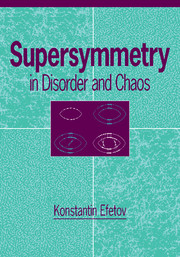Book contents
- Frontmatter
- Contents
- Preface
- Acknowledgments
- 1 Introduction
- 2 Supermathematics
- 3 Diffusion modes
- 4 Nonlinear supermatrix σ-model
- 5 Perturbation theory and renormalization group
- 6 Energy level statistics
- 7 Quantum size effects in small metal particles
- 8 Persistent currents in mesoscopic rings
- 9 Transport through mesoscopic devices
- 10 Universal parametric correlations
- 11 Localization in systems with one-dimensional geometry
- 12 Anderson metal–insulator transition
- 13 Disorder in two dimensions
- 14 Afterword
- Appendix 1 Calculation of the Jacobian
- Appendix 2 Magnetic field parametrization
- Appendix 3 Density–density correlation function at k = 0
- Appendix 4 Effective medium approximation as a saddle point
- References
- Author index
- Subject index
13 - Disorder in two dimensions
Published online by Cambridge University Press: 10 November 2010
- Frontmatter
- Contents
- Preface
- Acknowledgments
- 1 Introduction
- 2 Supermathematics
- 3 Diffusion modes
- 4 Nonlinear supermatrix σ-model
- 5 Perturbation theory and renormalization group
- 6 Energy level statistics
- 7 Quantum size effects in small metal particles
- 8 Persistent currents in mesoscopic rings
- 9 Transport through mesoscopic devices
- 10 Universal parametric correlations
- 11 Localization in systems with one-dimensional geometry
- 12 Anderson metal–insulator transition
- 13 Disorder in two dimensions
- 14 Afterword
- Appendix 1 Calculation of the Jacobian
- Appendix 2 Magnetic field parametrization
- Appendix 3 Density–density correlation function at k = 0
- Appendix 4 Effective medium approximation as a saddle point
- References
- Author index
- Subject index
Summary
Electron in a strong magnetic field
General remarks
Some aspects of electron motion in a two-dimensional (2D) disordered metal have been considered in Chapter 5. These were effects that could be studied by using the perturbation theory in diffusion modes. The renormalization group scheme is a way to sum up a certain class of graphs and is a straightforward extension of the simple perturbation theory. Although the first quantum correction, Eq. (5.23), contains many interesting effects that can be and have been confirmed by numerous experiments, some other interesting effects cannot be obtained in this simple manner.
One of the most interesting phenomena occurring in two dimensions is the quantum Hall effect (von Klitzing, Dorda, and Pepper (1980)). Since its discovery a lot of theoretical and experimental activity has been devoted to studying this effect and related properties of 2D electron gases. It makes no sense to review this direction of research here because many interesting and comprehensive reviews and books already exist (see, e.g., Prange and Girvin (1990), Büttiker (1992), Stone (1992), Aoki (1986), Janßen et al. (1994)). The aim of this section is to demonstrate only how the supersymmetry technique can help in studying electron motion in a 2D disordered metal.
In fact, in discussing theoretical aspects of the quantum Hall effect one should distinguish between the integer quantum Hall effect (occurring at integer filling factor vf) and the fractional effect discovered by Tsui, Stormer, and Gossard (1982).
- Type
- Chapter
- Information
- Supersymmetry in Disorder and Chaos , pp. 376 - 401Publisher: Cambridge University PressPrint publication year: 1996

